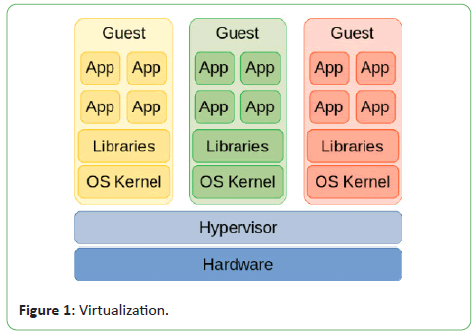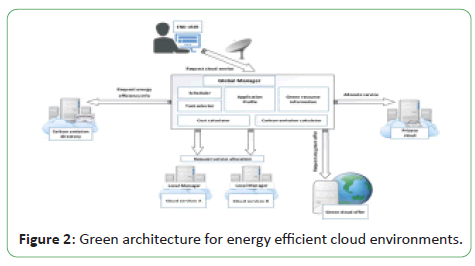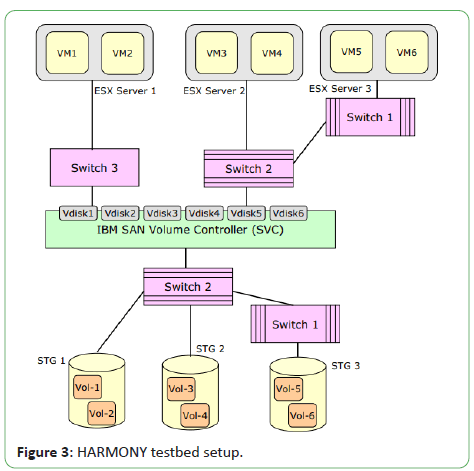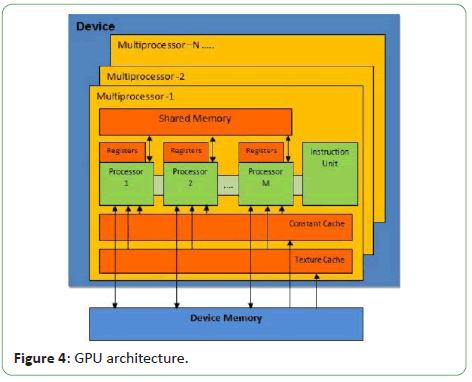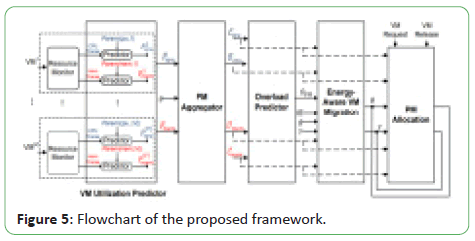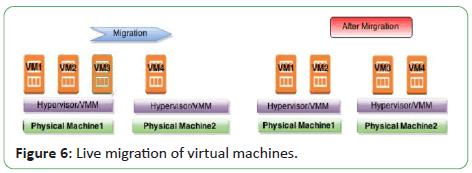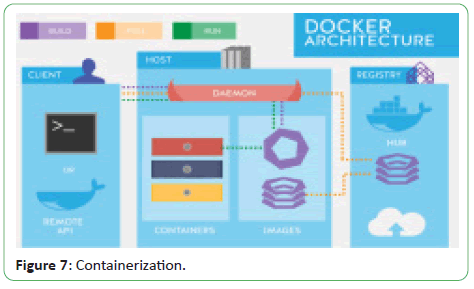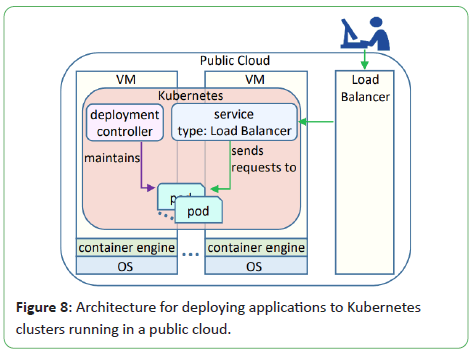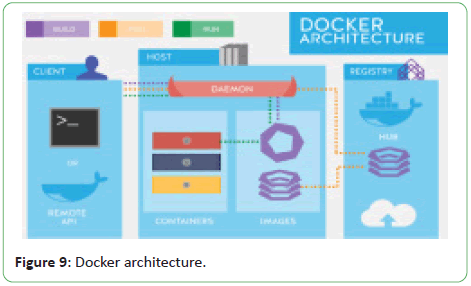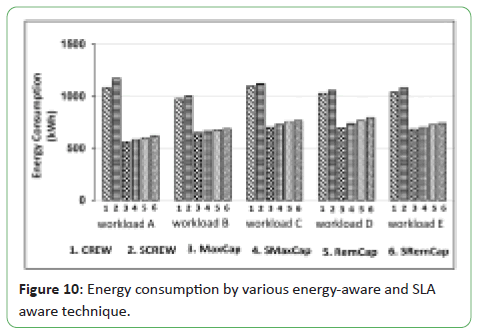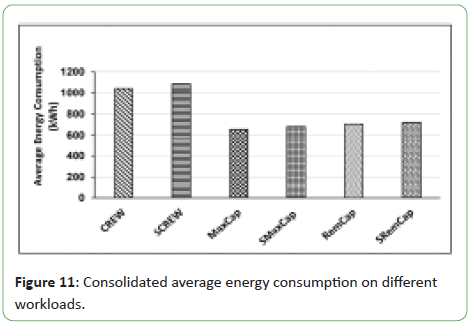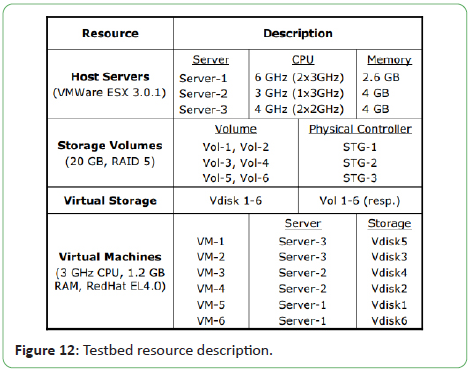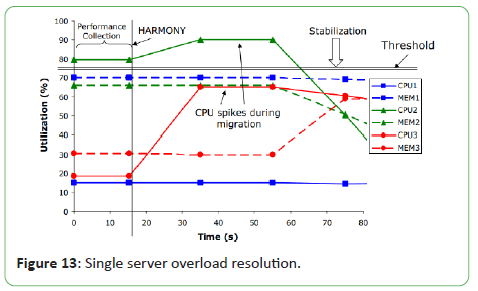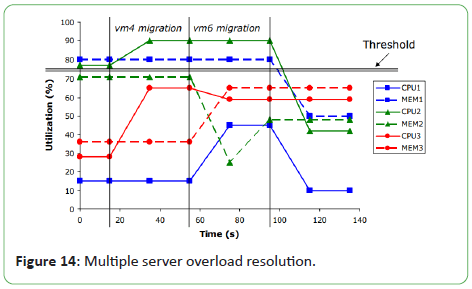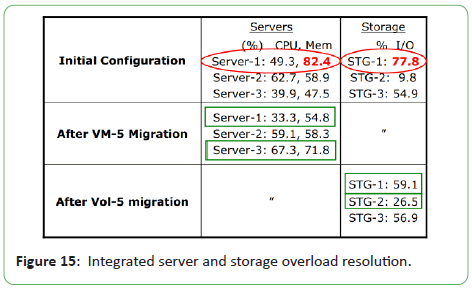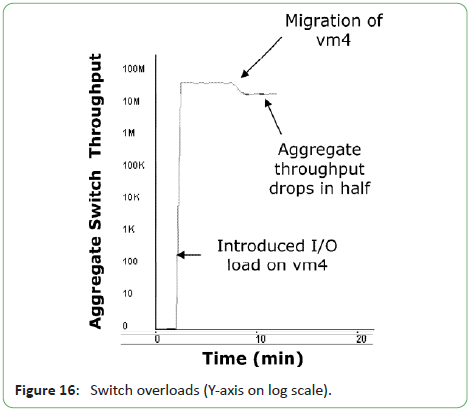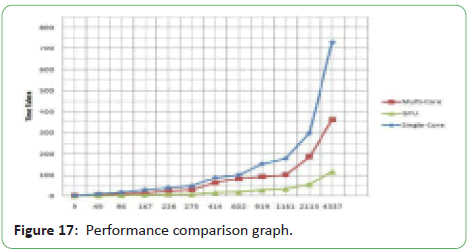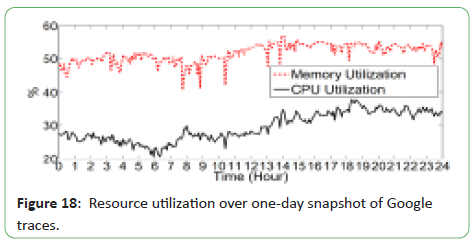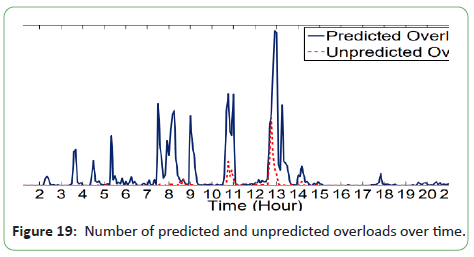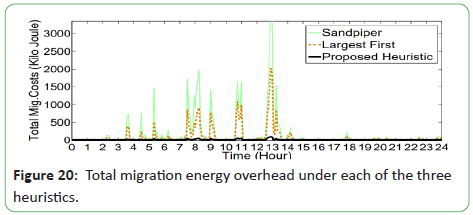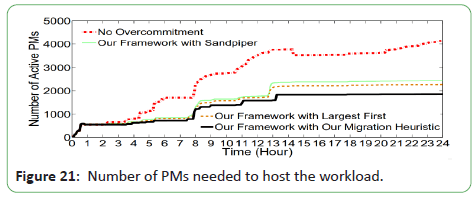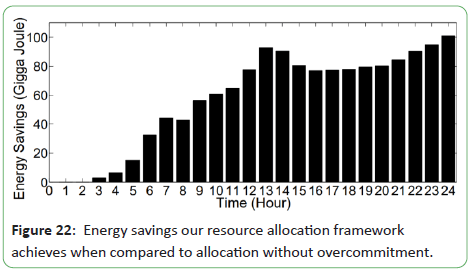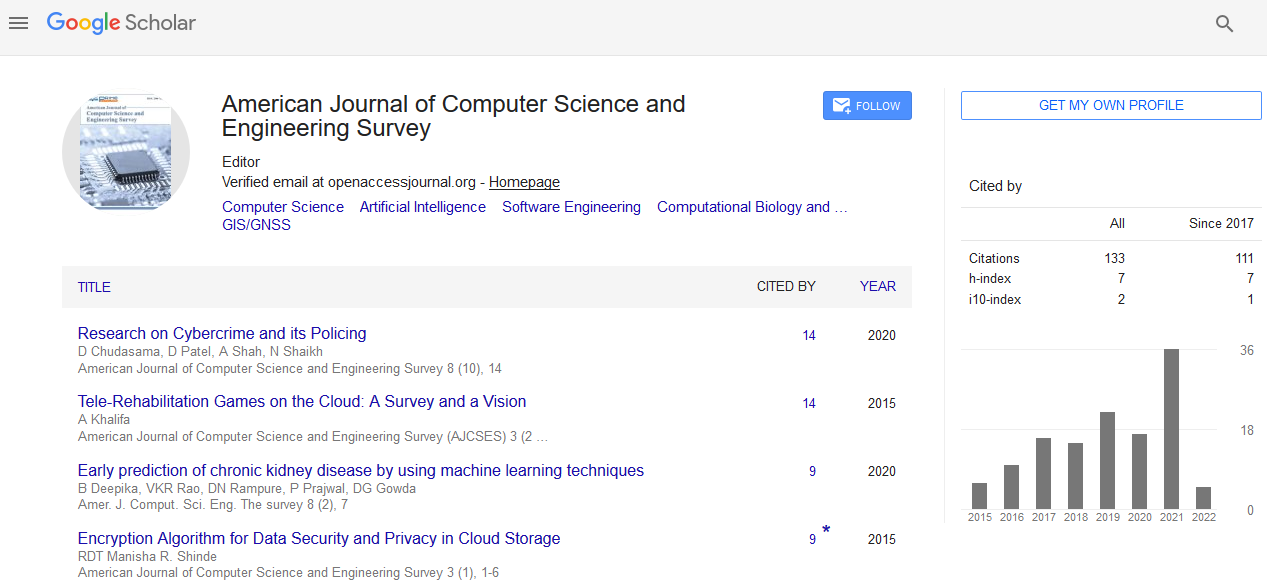Keywords
Virtualization; CPU: Central Processing Unit; RAM: Random Access
Memory; HDD: Hard Disk Drive.
Introduction
A data center contains tens of thousands of server machines
located in a single warehouse to reduce operational and
capital costs. Within a single data center modern application
are typically deployed over multiple servers to cope with their
resource requirements. The task of allocating resources to
applications is referred to as resource management. In particular,
resource management aims at allocating cloud resources in a
way to align with application performance requirements and to
reduce the operational cost of the hosted data center. However,
as applications often exhibit highly variable and unpredicted
workload demands, resource management remains a challenge.
A common practice to resource management has been to
over-provision applications with resources to cope even with
their most demanding but rare workloads. Although simple,
this practice has led to substantial under-utilization of data
centers since practitioners are devoting disjoint groups of server
machines to a single application. At the same time, the advent
of virtualization enables a highly configurable environment for
application deployment. A server machine can be partitioned into
multiple Virtual Machines (VMs) each providing an isolated server
environment capable of hosting a single application or parts of
it in a secure and resource assured manner. The allocation of
resources to VM can be changed at runtime to dynamically match
the virtualized application workload demands. Virtualization
enables server consolidation where a single physical server
can run multiple VMs while sharing its resources and running
different applications within the VMs. In addition, studies have
shown that reducing the frequency of VM migrations and server
switches can be very beneficial for energy saving. Ultimately,
server consolidation increases data center utilization and thus
reduces energy consumption and operational costs.
The main challenge of server consolidation is how to dynamically
adjust the allocation of VM resources so as to match the virtualized
application demands, meet their Service Level Objectives (SLOs)
and achieve increased server utilization. Towards this end, different
autonomic resource management methods have been proposed
to dynamically allocate resources across virtualized applications
with diverse workload and highly fluctuating workload demands.
Autonomic resource management in a virtualized environment
using control-based techniques has recently gained significant
attention [1].
With increasing scale and complexity of modern enterprise data
centers, administrators are being forced to rethink the design
of their data centers. In a traditional data center, application
computation and application data are tied to specific servers and
storage subsystems that are often over-provisioned to deal with
workload surges and unexpected failures. Such configuration
rigidity makes data centers expensive to maintain with wasted
energy and floor space, low resource utilizations and significant
management overheads.
Today, there is significant interest in developing more agile data
centers, in which applications are loosely coupled to the underlying
infrastructure and can easily share resources among themselves.
Also desired is the ability to migrate an application from one
set of resources to another in a non-disruptive manner. Such
agility becomes key in modern cloud computing infrastructures
that aim to efficiently share and manage extremely large data
centers. One technology that is set to play an important role in
this transformation is virtualization [2].
Virtualization
Virtualization is the process of decoupling the hardware from
the operating system on a physical machine. It turns what used
to be considered purely hardware into software. Put simply, you
can think of virtualization as essentially a computer within a
computer, implemented in software. This is true all the way down
to the emulation of certain types of devices, such as sound cards,
CPUs, memory, and physical storage. An instance of an operating
system running in a virtualized environment is known as a virtual
machine. The main idea of virtualization is to provide computing
resources as pools. Depending on the needs, resources are then
assigned to different applications either manually or dynamically
from different pools. The scope of virtualization can vary from
a single device to a large data centre and virtualization can be
applied to different areas such as servers, networks, storage
systems and applications.
Virtualization technology allows multiple virtual machines, with
heterogeneous operating systems to run side by side and in
isolation on the same physical machine. By emulating a complete
hardware system, from processor to network card, each virtual
machine can share a common set of hardware unaware that
this hardware may also be being used by another virtual
machine at the same time. The operating system running in the
virtual machine sees a consistent, normalized set of hardware
regardless of the actual physical hardware components. There
are some other types of Virtualization technology available.
For example, computer memory virtualization is software that
allows a program to address a much larger amount of memory
than is actually available. To accomplish this, we would generally
swap units of address space back and forth as needed between
a storage device and virtual memory. In computer storage
management, Virtualization is the pooling of physical storage
from multiple network storage devices into what appears to be a
single storage device that is managed from a central console. In
an environment using network virtualization, the virtual machine
implements virtual network adapters on a system with a host
network adapter.
The focus of server virtualization is to create virtual machines
or virtual environments by using normal server hardware and
a virtual machine software. Virtual machine software enables
sharing physical hardware among several instances called virtual
machines. Sharing is done by creating a special virtualization layer,
which transforms physical hardware into virtual devices seen by
virtual machines. The most visible change is the possibility to
run different operating systems (OS) within the same hardware
concurrently [3].
Virtualization is shown in Figure 1 [4].
Figure 1: Virtualization.
There are three different techniques used for virtualization which
mainly differ in the way they trap the privileged instructions
executed by the guest kernel.
Full virtualization with binary translation: In this approach, user
mode code runs directly on CPU without any translation, but
the non-virtualizable instructions in the guest kernel code are
translated on the fly to code which has the intended effect on the
virtual hardware.
Hardware assisted full virtualization: To make virtualization
simpler, hardware vendors have developed new features in
the hardware to support virtualization. Intel VT-x and AMD-V
are two technologies developed by Intel and AMD respectively
which provide special instructions in their ISA (Instruction Set
Architecture) for virtual machines and a new ring privilege level
for VM. Privileged and sensitive calls are set to automatically
trap to the Virtual Machine Manager (VMM), removing the need
for either binary translation or para-virtualization. It also has
modified Memory Management Unit (MMU) with support for
multi-level page tables and tagged translation look aside buffers
(TLBs).
Para-virtualization: This technique requires modification of the
guest kernel. The non-virtualizable/privileged instructions in the
source code of the guest kernel are replaced with hyper calls
which directly call the hypervisor. The hypervisor provides hyper
call interfaces for kernel operations like memory management,
interrupt handling, and communication to devices. It differs
from full virtualization, where unmodified guest kernel is used
and the guest OS does not know that it is running in a virtualized
environment [5].
Hypervisors can be distinguished into two categories: Type 1 and
Type 2. Type 1 hypervisors or bare-metal hypervisors run directly
and exclusively on the hardware and provide virtual machine
environments to the guest operating systems. Type 1 hypervisors
are commonly used for cloud computing infrastructure such as
Amazon’s Elastic Compute Cloud (EC2), Microsoft’s Azure Cloud,
VMWare, Elastic Sky X (ESX) and Xen. A Type 1 hypervisor is also what engineers would use for virtualization on embedded
systems. Type 2 hypervisors or hosted hypervisors run as an
application program inside another operating system, the host,
and hence share the host resources with other applications
running next to them. Type 2 hypervisors are often used in
desktop environments. Examples are Oracle Virtual Box or
VMWare. KVM-QEMU is a popular hosted hypervisor which
runs on top of the Linux operating system. Kernel-based Virtual
Machine (KVM) is a kernel module providing support for hardware
assisted virtualization in Linux while, Quick Emulator (QEMU) is a
user space emulator. KVM uses QEMU mainly for emulating the
hardware. So, both these pieces of software work together as
a complete hypervisor for Linux. KVM-QEMU and Xen are open
source while ESX is proprietary [4,5].
There is a correlation between energy consumption, system
structures, performance and task workload in the virtual
machines. When jobs are running in the virtual machines
resources are employed such as CPU, memory, disk, network
bandwidth which direct to energy consumption [6].
Literature Survey
Gul B et al. proposed two energy-aware Virtual Machine
(VM) consolidation schemes that take into account a server’s
capacity in terms of CPU and RAM to reduce the overall energy
consumption. The proposed schemes are compared with existing
schemes using CloudSim simulator. The results show that the
proposed schemes reduce the energy cost with improved Service
Level Agreement (SLA).
They consider a cloud network of data centers (DCs) consisting
of a large number of heterogeneous servers. Every server has
its processing speed, memory, storage capacity, and energy
consumption. Each individual server is represented by CPU
capacity which is calculated in Million Instructions per Second
(MIPS), a Random Access Memory (RAM) and a bandwidth.
Servers contain local disks to host Operating Systems (OS)
whereas Network Attached Storage (NAS) is used to store VMs
and to enable live migration of VMs. Large number of cloud
users can submit request for M number of VMs where each VM
consists of its own load of CPU, memory utilization, and network
transfer rate. For the management of resources, the proposed
system consists of two layers: (a) a global manager and (b) a local
manager as shown in Figure 2. Carbon emission directories are
maintained for keeping energy efficiency information.
Figure 2: Green architecture for energy efficient cloud environments.
Moreover, the schemes utilize a threshold mechanism in order
to keep some resources free to tackle the increased resource
demands at run time. They subdivide the resource allocation
problem into two components: (a) host selection and (b) VM
placement. The proposed techniques take into account a PM’s
capacity and energy consumption while placing VMs on a server
[7].
Singh A et al. describe the design of an agile data center with
integrated server and storage virtualization technologies. Such
data centers form a key building block for new cloud computing
architectures. They also show how to leverage this integrated
agility for non-disruptive load balancing in data centers across
multiple resource layers-servers, switches, and storage. They
propose a novel load balancing algorithm called VectorDot
for handling the hierarchical and multi-dimensional resource
constraints in such systems. The algorithm, inspired by the
successful Toyoda method for multi-dimensional knapsacks, is
the first of its kind.
They evaluate their system on a range of synthetic and real data
center testbeds comprising of VMware ESX servers, IBM SAN
Volume Controller, Cisco and Brocade switches. Experiments
under varied conditions demonstrate the end-to-end validity of
their system and the ability of VectorDot to efficiently remove
overloads on server, switch and storage nodes.
They describe their system HARMONY that integrates server and
storage virtualization in a real data center along with a dynamic
end-to-end management layer. It tracks application computation
(in the form of VMs) and application data (in the form of Virtual
disks (V disks)) and continuously monitors the resource usages of
servers, network switches, and storage nodes in the data center.
It can also orchestrate live migrations of virtual machines and
virtual disks in response to changing data center conditions [2]. Figure 3 shows the data center testbed.
Figure 3: HARMONY testbed setup.
Gupta S and Babu MR, compare the performance of a singlecore
CPU, multi-core CPU and GPU using a Natural Language
Processing application.
The programming over a GPU follows a Single Instruction
Multiple-Data (SIMD) programming model. For efficiency, GPU processes many elements in parallel using the same program.
Each element is independent from the other elements, and in
the base programming model, elements cannot communicate
with each other. All GPU programs must be structured in this way: many parallel elements each processed in parallel by a
single program.
The Graphics Processing Units (GPU) are highly parallel rapidly gaining maturity as a powerful engine for computationally demanding applications. The GPU’s performance and potential will be the future of computing systems.
General Purpose GPU (GPGPU) is a combination between
hardware components and software that allows the use of a
traditional GPU to perform computing tasks that are extremely
demanding in terms of processing power. Traditional CPU
architectures available on the market cannot satisfy the
processing demands for these specific tasks, and thus the market
has moved on to GPGPU in order to achieve greater efficiency is
shown in Figure 4.
Figure 4: GPU architecture.
NVIDIA has developed Compute Unified Device Architecture
(CUDA) which allows the use of the C programming language
to code algorithms to execute on the GPU. CUDA enabled GPUs
include data parallel cache. Besides the flexible interface for
programming, it also supports memory scatter bringing more
flexibilities to GPU.
CUDA provides a C-like syntax for executing on the GPU and
compiles offline. CUDA exposes two levels of parallelism, data
parallel and multithreading. CUDA also exposes multiple levels
of memory hierarchy: per-thread registers, fast shared memory
between threads in a block, board memory, and host memory. Kernels in CUDA allow the use of pointers, general load/store to
memory allowing the user to scatter data from within a kernel,
and synchronization between threads in a thread block. However,
all of this flexibility and potential performance gain comes with
the cost of requiring the user to understand more of the lowlevel
details of the hardware, notably register usage, thread
and thread block scheduling, and behaviour of access patterns
through memory. All of these systems allow developers to more
easily build large applications [8].
Dabbagh M et al. propose an efficient resource allocation
framework for overcommitted clouds that makes great energy
savings by 1) minimizing PM overloads via resource usage
prediction, and 2) reducing the number of active PMs via efficient
VM placement and migration. Using real Google traces collected
from a cluster containing more than 12K PMs, they show that their
proposed techniques outperform existing ones by minimizing
migration overhead, increasing resource utilization, and reducing
energy consumption.
Their proposed framework is suited for heterogeneous cloud
clusters who’s PMs may or may not have different resource
capacities. They consider in this work two cloud resources: CPU
and memory, although their framework can easily be extended
to any number of resources. Their framework is made up of five
modules:
• VM utilization predictor
• PM aggregator
• PM overload predictor
• Energy-aware VM migration
• PM allocation
Flowchart of the proposed framework is shown in Figure 5.
Figure 5: Flowchart of the proposed framework.
In memory overcommitment, more memory is allocated to the
virtual machines (VMs) than is physically present in hardware. This
is possible because hypervisors allocate memory to the virtual
machines on demand. KVM-QEMU treats all the running VMs as
processes of the host system and uses malloc to allocate memory
for a VM’s RAM. Linux uses demand paging for its processes, so a
VM on boot up will allocate only the amount of memory required
by it for booting up, and not its whole capacity.
On demand memory allocation in itself is not enough to make
memory over commitment a viable option. There is no way for the hypervisor to free a memory page that has been freed by the
guest OS. Hence a page once allocated to a VM always remains
allocated. The hypervisor should be able to reclaim free memory
from the guest machines, otherwise the memory consumption of
guest machines will always keep on increasing till they use up all
their memory capacity. If the memory is overcommitted, all the
guests trying to use their maximum capacity will lead to swapping
and very poor performance.
There exists a mechanism called memory ballooning to reclaim
free memory from guest machines. This is possible through a
device driver that exists in guest operating system and a backend
virtual device in the hypervisor which talks to that device driver.
The balloon driver takes a target memory from the balloon device.
If the target memory is less than the current memory of the VM, it
allocates (current-target) pages from the machine and gives them
back to the hypervisor. This process is called balloon inflation. If
the target memory is more than the current memory, the balloon
driver frees required pages from the balloon. This process is
called balloon deflation. Memory ballooning is an opportunistic
reclamation technique and does not guarantee reclamation. The
hypervisor has limited control over the success of reclamation and
the amount of memory reclaimed, as it depends on the balloon
driver which is loaded inside the guest operating system [9]. Jin
K and Miller EL propose the use of deduplication to both reduce
the total storage required for VM disk images and increase the
ability of VMs to share disk blocks. To test the effectiveness of
deduplication, they conducted extensive evaluations on different
sets of virtual machine disk images with different chunking
strategies. Their experiments found that the amount of stored
data grows very slowly after the first few virtual disk images if
only the locale or software configuration is changed, with the rate
of compression suffering when different versions of an operating
system or different operating systems are included. They also
show that fixed length chunks work well, achieving nearly the
same compression rate as variable-length chunks. Finally, they
show that simply identifying zero-filled blocks, even in readyto-
use virtual machine disk images available online can provide
significant savings in storage [10].
Methodology
In a virtualization environment, consolidation of virtual machines
is one of the techniques used to save the operational costs of
data centers. Hence, virtual machine consolidation refers to
the use of a physical server to accommodate more than one
virtual machine for the efficient use of resources. Co-locating
(consolidating) VMs reduces the number of physical servers and
reduce server sprawl, a situation in which multiple, underutilized
servers take up more space and consume more resources than
can be justified by their workload. In addition, VM consolidation
reduces the power consumption, since power consumption
and the number of servers is directly related. VM consolidation
can be performed in three ways: a) static, in which the virtual
machine monitor (hypervisor) allocates the resource (physical
resource such as memory, CPU and the likes) once and VMs
will stay for long time period (such as months and years) on
one physical machine. That means there will be no adjustment to the variation of workloads; b) Semi-static, in which VMs are
place based on daily or weekly bases; c) Dynamic, by adjusting
depending on the workload characteristics (Peak and off-peak
utilization of resources) and make adjustment in hours and needs
run-time placement algorithms. Dynamic VM consolidation helps
in the efficient use of data centers. In order to consolidate VMs
there are several processes that must be undertaken. These are
VM selection, VM placement and VM migration.
VM selection is one of the challenges of VM consolidation
process. It deals with migrating VMs until the physical machine is
considered to be not overloaded. In VM selection process there
are several policies to be followed for effective accomplishment
of the process. These policies are: a) The minimum Migration
Time Policy; b) The Maximum Correlation Policy; c) The Random
Choice Policy and; d) Highest Potential Growth (HPG). Moreover,
it is also described as: a) Local Regression b) Interquartile Range
c) Median Absolute deviation.
The process of selecting the most suitable host for the virtual
machine, when a virtual machine is deployed on a host, is known
as virtual machine placement, or simply placement. During
placement, hosts are rated based on the virtual machine’s
hardware and resource requirements and the anticipated
usage of resources. Host ratings also take into consideration the
placement goal either resource maximization on individual hosts
or load balancing among hosts. The administrator selects a host
for the virtual machine based on the host ratings.
Migration of VM’s can be accomplished by two methods: offline
migration, which has downtime because of suspend and resume
of operation and; live migration, which is widely used in cloud
computing and uses copying before migrating to avoid downtime.
One of the most remarkable features of virtualization is live
migration of VMs. In live migration active VM is transferred from
one physical machine to other keeping the current working status
of a VM while running. Such actions are a de facto in KVM and
Xen. Live migration of virtual machines is shown in Figure 6.
Figure 6: Live migration of virtual machines.
Fault Tolerant Migration migrates the VMs even-if system failure
occurs during migration. It was assumed to minimize performance
degradation of applications and improve availability.
Load Balancing Migration distributes load across the physical
servers to improve the scalability of physical servers. It helps
in minimizing the resource consumption, implementation of
fail-over, enhancing scalability, avoiding bottlenecks and over
provisioning of resources etc.
The Energy Efficient Migration conserves the energy of servers
by optimum resource utilization, since the power consumption of data center is mainly based on the utilization of the servers and
their cooling systems [11].
Micro services are a style of software architecture that involves
delivering systems as a set of very small, granular, independent
collaborating services. The micro service architectural style is an
approach to developing a single application as a suite of small
services, each running in its own process and communicating
with lightweight mechanisms, often an HTTP resource API.
In micro services pattern, a software system is comprised of a
number of independently deployable services, each with a
limited scope of responsibility. Less frequently, micro services
may rely on lower level services. Here each micro service can be
developed, managed and scaled independently throughout its
life-cycle. A well implemented micro services architecture also
ensures that the overall system is able to gracefully degrade its
functionality when one or more services are offline.
Containerization is also known as Operating System Virtualization.
As the name implies, the abstraction is the operating system
itself, instead of the platform. It is an approach to virtualization
in which the virtualization layer runs as an application within the
Operating System (OS). Here, the operating systems kernel runs
on the hardware with several isolated guest Virtual Machines
(VMs) installed above it. The isolated guest virtual machines are
called containers.
Here the operating system provides a set of user-spaces that are
isolated from one another, but offers the abstraction necessary
such that applications believe that they are part of the singular
user-space on the host. With container-based virtualization, the
overhead associated with having each guest run a completely
installed operating system is not there. Here there is just one
operating system taking care of hardware calls, thus it improves
performance. However, each guest must use the same operating
system the host uses, which results in restriction for user [12].
Containerization is shown in Figure 7 [4].
Figure 7: Containerization.
Kubernetes is a framework designed to manage containerized
workloads on clusters. The basic building block in Kubernetes is a
pod. A pod encapsulates one or more tightly coupled containers
that are co-located and share the same set of resources. Pods
also encapsulate storage resources, a network IP, and a set of
options that govern how the pod’s container(s) should run. A pod is designed to run a single instance of an application; in this way
multiple pods can be used to scale an application horizontally for
example. The amount of CPU, memory, and ephemeral storage
a container needs can be specified when creating a pod. This
information can then be used by the scheduler to make decisions
on pod placement. These computer resources can be specified
both as a requested amount and as a limit on the amount the
container is allowed to consumer.
The default Kubernetes scheduler ensures that the total amount
of compute resource requests of all pods placed in a node does
not exceed the capacity of the node. This even if the actual
resource consumption is very low. The reason behind this is to
protect applications against a resource shortage on a node when
resource usage later increases (e.g., during a daily peak). If a
container exceeds its memory limit, it may be terminated and
may be later restarted. If it exceeds its memory request, it may
be terminated when the node runs out of memory. Regarding the
CPU usage, containers may or may not be allowed to exceed their
limits for periods of time, but they will not be killed for this. On
the other hand, containers and pods that exceed their storage
limit will be evicted [13].
Architecture for deploying applications to Kubernetes clusters
running in a public cloud is shown in Figure 8 [14].
Figure 8: Architecture for deploying applications to Kubernetes
clusters running in a public cloud.
The Docker platform was released in March 2013 as an open-source
project based on Linux containers (LXC) and a year later,
the environment was moved from LXC to lib container. Docker
is based on the principles of containerization, allowing for an
easy deployment of applications within software containers
as a result of its innovative and unique architecture. Docker
implements certain features that were missing from OS-level
virtualization. It bundles the application and all its dependencies
into a single object, which can then be executed in another
Docker enabled machine. This assures an identical execution
environment regardless of the underlying hardware or OS. The
creation of applications in Docker is firmly rooted in the concept
of versioning. Modifications of an application are committed
as deltas, which allows roll backs to be supported and the
differences to previous application versions to be inspected. This
is an exceptional method of providing a reliable environment for developers. Furthermore, Docker promotes the concept of
reusability, since any object that is developed can be re-used
and serve as a “base image” to create some other component.
Another essential aspect of Docker is that it provides developers
with a tool to automatically build a container from their source
code.
The main difference between a Docker container and a VM is that
while each VM has its own OS, dependencies and applications
running within it, a Docker container can share an OS image
across multiple containers. In essence, a container only holds the
dependencies and applications that have to be run within them.
For example, assuming a group of containers were making use of
the same OS image, the OS would be common to all containers
and not be duplicated contrary to the case of a VM topology.
Docker has become the flagship in the containerization technology
arena since its release. This open-source project has gained much
notoriety in the field of cloud computing, where major cloud
platforms and companies (e.g., Google, IBM, Microsoft, AWS,
Rackspace, RedHat, VMware) are backing it up. These companies
are integrating Docker into their own infrastructures and they
are collaborating in Docker’s development. Recently, a few
alternatives to Docker have cropped up, such as Rocket, Flockport
and Spoonium [15]. Figure 9 shows Docker Architecture [16].
An adequate monitoring of the pool of resources is an essential
aspect of a cloud computing infrastructure. The monitoring
of resources leads to improved scalability, better placement of
resources, failure detection and prevention, and maintenance of
architectural consistency, among others. This is relevant for VMs,
and it is just as applicable to OS-level virtualization [15].
Figure 9: Docker architecture.
Storage efficiency is the process of storing and managing data
while consuming the least space possible and ensuring optimal
performance. This means solving problems while consuming less
storage.
For many years, Storage Area Networks (SAN) and Network
Attached Storage (NAS) were at the core of different parts of the
data center. SANs are primarily used to make storage devices,
such as disk arrays accessible to servers so that the devices
appear like locally attached devices to the operating system. NAS
was introduced to the market in the 1990’s to accommodate the
growing demand for file sharing via the IP network.
Thin provisioning is the act of using virtualization technology to give the appearance of more physical resource than is actually
available. Traditional block storage requires all blocks to be
assigned up front. This means large pools of storage are allocated
to servers and remain unused. Thin provisioning allows disk to
be added as needed. This means the initial acquisition costs can
be reduced and further, because of the price of disk goes down
over time, the long-term costs are also reduced as compared to
tradition arrays that utilize thick provisioning.
Deduplication is a technology that can be used to reduce the
amount of storage required for a set of files by identifying
duplicate “chunks” of data in a set of files and storing only one
copy of each chunk [10].
It is the method of reducing storage needs by eliminating
duplicate data. Only one instance of the data resides on the disk
and duplicate or redundant data is replaced with a pointer to the
original.
Most think of single instance storage when it comes to dedupe
but focusing there would only be part of the equation. To illustrate
single instance storage or file level deduplication think of email.
A user sends a spreadsheet to 10 different people. Those people
all save the file on the file share and we have 10 copies in both
the email system and the file server. All copies are exact copies,
even down to the file name, so file level deduplication stores the
file only once and replaces the duplicate copies with pointers to
the original.
A more advanced and useful form of deduplication is block
level or sub file level deduplication. Block deduplication looks
within a file and saves unique iterations of each block. Think
of a PowerPoint with a common corporate format. There are
hundreds of presentations on the file share, all with the same
slide design and graphics but each with their own unique content.
Block level deduplication removes all the duplicate pieces of each
and replaces with a pointer to the original.
An even more powerful example is block level deduplication
within a virtualized server environment. Imagine a virtualized
server environment with 100 VMs all with MS Windows Server
2008 R2 as the operating system. Let’s say that operating system
is 8 GB for each instance. That is 800 GB of operating system data,
each basically a duplicate of the other. Block level deduplication
replaces each block of duplicate data with a pointer and reduces
the data footprint just associated to the operating system by 90%
[17].
Findings
Gul B et al. results show that proposed energy-aware and SLA-aware
schemes outperform the existing energy-aware and SLA-aware
schemes. Improvement in results is due to improving
energy efficiency which is made possible by decreasing the
number of active servers. Moreover, proposed schemes monitor
resource utilization to gather updated information while the
existing schemes consider only maximum energy consumption
for initial host selection. In their study, capacity of CPU is
considered during VM placement. The server that provides
maximum RAM and CPU capacities per watt power is selected for VM placement. In this way, energy consumption is improved
as compared to existing Cloud Resilience for Windows (CREW).
For instance, Maximum Capacity and Power Technique (MaxCap)
consumes 37% less energy than CREW and Remaining Capacity
and Power (RemCap) consumes 32% less energy than CREW. The
proposed SLA-aware version SMaxCap consumes 35% less energy
than SCREW and SRemCap consumes 31% less energy than the
SLA-aware versions SCREW [7].
Figures 10 and 11 presents the comparison of energy consumption
for various PlanetLab workloads. Comparisons of their proposed
energy-aware schemes (MaxCap and RemCap) and SLA-aware
schemes (SMaxCap and SRemCap) are performed with existing
energy-aware and SLA-aware techniques, namely: CREW and
SCREW, respectively [7].
Figure 10: Energy consumption by various energy-aware and SLA
aware technique.
Figure 11: Consolidated average energy consumption on different
workloads.
Singh A et al. for end-to-end validation of HARMONY in a real
data center setup, created four scenarios in their testbed that
caused overloads on multiple dimensions of servers, storage and
switches. When any of the overloads are detected by HARMONY
Performance Manager, it uses VectorDot to determine virtual
resources that can be migrated and their destinations. It then uses
the HARMONY Virtualization Orchestrator to execute suggested
server and/or storage migrations by VectorDot. The description
of all resources including virtual machines to host and storage mappings are shown in Figure 12 [2].
Figure 12: Testbed resource description.
As a first scenario, they overloaded Server-2 on the CPU
dimension by creating a high CPU workload on VM-4. Figure 13 shows the CPU and memory utilizations for all three servers with
elapsed time.
Figure 13: Single server overload resolution.
In the second scenario they created a CPU overload on Server-2
and a memory overload on Server-1 by increasing usages of VM-4
and VM-6 respectively. Figure 14 shows utilizations with elapsed
time.
Figure 14: Multiple server overload resolution.
In the third scenario, they generated a high I/O workload on VM-5
which accesses Vdisk1 (from Vol-1 on STG-1). They also added a memory workload to create an overload on VM-5’s host server
Server-1. To show utilizations for multiple resource types, they
tabulated the CPU and memory utilization of servers, and storage
I/O utilization of storage controllers in Figure 15.
Figure 15: Integrated server and storage overload resolution.
In the fourth scenario, they fixed the capacity of Switch-2 to
50 MBps. They then generated an I/O workload on VM-4 (that
uses Vdisk2 virtualized from Vol-2 on STG1) at the rate of 20
MBps. Since Switch-2 receives I/O from both Server-2 and the
virtualization appliance (it is both above and under the appliance) (Figure 3) the workload generates 40 MBps on Switch-2. Figure 16 shows the actual performance monitor screenshot from the
switch management interface (Y-axis on log scale).
Figure 16: Switch overloads (Y-axis on log scale).
Their validation experiments demonstrate the feasibility of their
integrated load balancing approach in a real deployment [2].
Gupta S and Babu MR, for their evaluation, in comparing the
performance of GPU and CPU (single-core and multi-core) using
an NLP application, used the following platforms.
• NVIDIA GeForce G210M 1024MB (800MHz GDDR3, 16 cores)
• CUDA version 2.1
• Open MP
• Intel Core 2 Duo CPU P8600 (2.40 GHz, 2CPUs)
• Intel C++ Compiler 10.0
As per their algorithm used, for some particular size of file (in
terms of number of words in a file) their system processes the
input file (performs lexical analysis and shallow parsing) and
finally provides the number of matches and number of parts of
speech in the provided input file [8]. The graph generated on
some of the data generated on the implementation of algorithm
used is displayed in Figure 17 [8].
Figure 17: Performance comparison graph.
Dabbagh M et al. experiments presented in this section are based
on real traces of the VM requests submitted to a Google cluster
that is made up of more than 12K PMs. Since the size of the traces
is huge, they limit their analysis to a chunk spanning a 24 hours
period.
Resource utilization over one-day snapshot of Google traces is
shown in Figure 18.
Figure 18: Resource utilization over one-day snapshot of Google
traces.
Number of predicted and unpredicted overloads over time is
shown in Figure 19.
Figure 19: Number of predicted and unpredicted overloads over time.
Figure 20 plots the total migration energy overhead (including
both VM moving and PM switching overheads) incurred by the migration decisions of their proposed heuristic to avoid/handle the overloads reported in Figure 19 along with the total energy overhead associated with the migration decisions of the two
existing heuristics: Largest First and Sandpiper. Both of these
heuristics handle multi-dimensional resources by considering the
product metrics, and both select the PM with the largest slack as
a destination for each migrated VM.
Figure 20: Total migration energy overhead under each of the three
heuristics.
Since the energy consumed by ON PMs constitutes a significant
amount, they analyze in Figure 21 the number of ON PMs when
running our framework on the Google traces under each of the
three studied migration heuristics.
Figure 21: Number of PMs needed to host the workload.
Figure 22 shows the total energy savings when the Google cluster
adapts their integrated framework (the proposed prediction
approach and the proposed migration heuristic) compared to no
overcommitment.
Figure 22: Energy savings our resource allocation framework
achieves when compared to allocation without overcommitment.
It is clear from Figure 22 that although their framework incurs migration energy overheads (due to both VM moving and PM
switching energy overheads) that would not otherwise be present
when no overcommitment is applied, the amount of energy saved
due to the reduction of the number of ON PMs is much higher
than the amount of energy incurred due to migration energy,
leading, at the end, to greater energy savings [9].
Conclusion
Gul B et al. observed that techniques perform better with dynamic
threshold as compared to static threshold, and the dynamic
threshold has a positive impact on minimizing SLA violations.
Singh A et al. developed a novel VectorDot scheme to address
the complexity introduced by the data center topology and
the multidimensional nature of the loads on resources. Their
evaluations on a range of synthetic and real data center testbeds
demonstrate the validity of their system and the ability of
VectorDot to effectively address the overloads on servers,
switches, and storage nodes.
Gupta S and Babu MR compared the performance of a GPU
with single-core and multi-core CPU (2 cores) for a basic NLP
application (lexical analysis and shallow parsing). Their results
show that a multi-core CPU has better performance than the
single-core CPU but a GPU system has clearly overtaken them
with much better performance.
Dabbagh M et al. propose an integrated energy-efficient,
prediction-based VM placement and migration framework for
cloud resource allocation with overcommitment. They show that
their proposed framework reduces the number of PMs needed
to be ON and decreases migration overheads, thereby making
significant energy savings. All of their findings are supported by
evaluations conducted on real traces from a Google cluster.
References
- Makridis E, Deliparaschos K, Kalyvianaki E, Zolotas A, Charalambous T (2020) Robust dynamic CPU resource provisioning in virtualized servers. IEEE Trans Serv Comput: 1-1.
- Singh A, Korupolu M, Mohapatra D (2008) Server-storage virtualization: Integration and load balancing in data centers. SC '08: Proceedings of the 2008 ACM/IEEE Conference on Supercomputing, 2008.
- Singh S, Goyal M (2015) Review paper on resource utilization and performance optimization of CPU using virtualization. Int J Adv Res Comput Commun Eng 4: 383-385.
- Streif, RJ (2019) Containerization an alternative to virtualization in embedded systems. www.ibeeto.com, 2019.
- Gangadhar PVSS, Venkateswara Rao M, Hota A K, Venkateswara Rao V (2017) Distributed memory and CPU management in cloud computing environment. Int J Appl Eng Res 12: 15972-15978.
- Nema P, Choudhary S, Nema T (2015) VM consolidation technique for green cloud computing. Int J Comput Sci Inf Technol 6: 4620-4624.
- Gul B, Khan IA, Mustafa S, Khalid O, Hussain SS, et al. (2020) CPU and RAM energy-based sla-aware workload consolidation techniques for clouds. IEEE Access 8: 62990-63003.
- Gupta S, Babu MR (2011) Generating performance analysis of GPU compared to single-core and multi-core cpu for natural language applications. Int J Adv Comput Sci Appl 2: 50-53.
- Dabbagh M, Hamdaoui B, Guizani M, Rayes A (2015). Efficient datacenter resource utilization through cloud resource overcommitment. 2015 IEEE Conference on Comput Commun Workshops (INFOCOM WKSHPS).
- Jin K, Miller EL (2009) The effectiveness of deduplication on virtual machine disk images. Proceedings of SYSTOR 2009: The Israeli Experimental Systems Conference: 1-12.
- Alla YH (2015) Time dependent virtual machine consolidation with sla (service level agreement) consideration. Master’s Thesis Spring 2015.
- Kukade PP, Kale G (2013) Auto-scaling of micro-services using containerization. Int J Sci Res 4: 1960-1963.
- Rodriguez MA, Buyya R (2018) Containers orchestration with cost-efficient autoscaling in cloud computing environments. arXiv.org: 1-22.
- Vayghan LA, Saied MA, Toeroe M, Khendek F (2019) Kubernetes as an availability manager for microservice applications. J Netw Comput Appl: 1-10.
- Jimenez LL, Simon MG, Schelen O, Kristiansson J, Synnes K, et al.(2015) CoMA: Resource monitoring of Docker containers. Proceedings of the 5th International Conference on Cloud Computing and Services Science (CLOSER 2015), SCITEPRESS Digital Library 1: 145-154.
- Shanmugam AS (2017) Docker Container Reactive Scalability and Prediction of CPU Utilization Based on Proactive Modelling. Sematic Scholar: 1-24.
- IP Pathways (2012) Storage efficiency and the rapidly growing data center footprint. ippathways.com, 2012.

